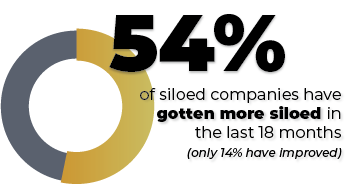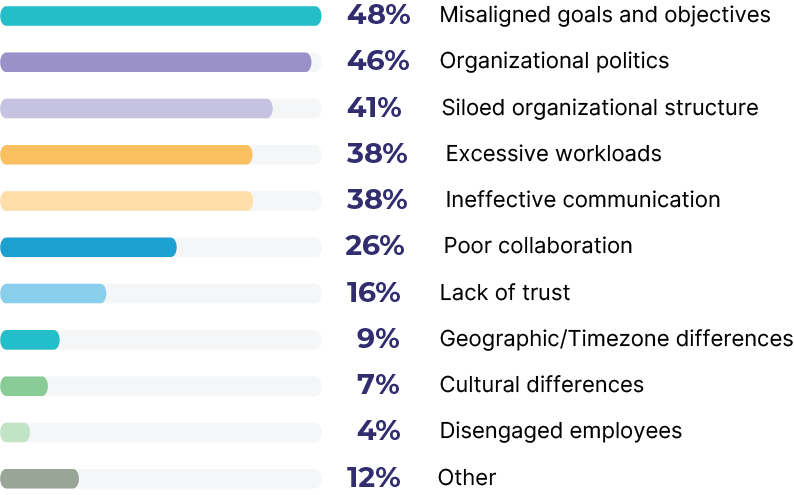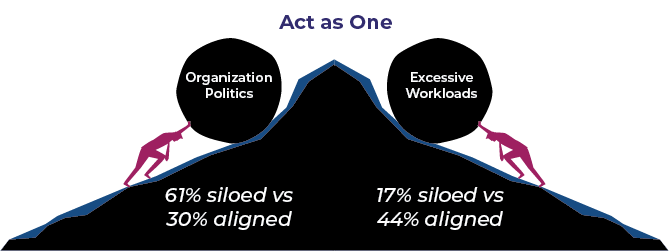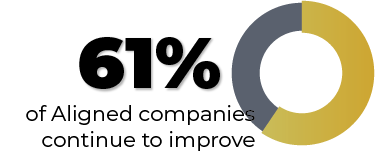Leadership & Management70
Bridging the Divide
Can organizations operate in alignment to achieve goals that span teams, functions, and divisions?
Evan Leybourn
June 10, 2024
Can organizations operate in alignment to achieve goals that span teams, functions, and divisions?
Evan Leybourn
June 10, 2024
Bridging the Divide: Can organizations operate in alignment to achieve goals that span teams, functions, and divisions?
This study seeks to understand the factors contributing to the sharp decline in the ability for organizations to Act as One. Our goal is to explore macro trends in work dynamics, global economic factors, and changes in organizational culture.



“Due to the siloed nature of the company, each [senior executive] focused on building their own area, employing people well outside their budget [to meet their company objectives], assuming that other areas would make cuts.”
~Survey Respondent
When this rolled up to a company level, we were extremely over budget and have to now take drastic measures to cut costs (aka jobs) in the organisation, which is frustrating because the people [cut] are not the ones responsible for this original mess!”
~Survey Respondent
Rather than locally optimizing a part of your organization, it’s critical to encompass the whole system. Acting as a seamless, unified front ensures that the customer enjoys a consistant experience.

Learn more about the Domains of Business Agility.

When comparing the differences between Siloed vs Aligned organizations, we found that Organizational Politics was a greater impediment for Siloed organizations. Reported by 61% of siloed organization report vs only 30% of aligned organizations.
On the other hand, Excessive Workloads was the greatest impediment for Aligned organizations. This was reported by 17% of siloed organization compared to 44% of aligned organizations.

We asked organizations to share the tangible and measurable costs & impacts caused by their proficiency, or lack thereof, in Acting as One. What emerged was a trend where Aligned companies generally saw positive results, while Siloed and Neutral companies reported decreases in key business areas.
Reduced Employee Morale & Retention
74% of Siloed companies report that employee morale and retention dropped (as high as 25% in some organizations).
50% of Aligned companies say morale and retention goes up.
Decreased Productivity
65% of Siloed companies report a significant drop in productivity leading to duplicated effort, project delays (100+ days), and budgetary issues. Many organizations shared that this led to job-cuts and cost-cutting measures.
59% of Aligned companies say productivity has increased.
Stifled Innovation
61% of Siloed companies state that innovation has been sifled. This is especialy true of companies that report that their ability to Act as One is getting worse.
32% of Aligned companies say innovation has improved.
Missed Opportunities
48% of Siloed orgs report a material impact on their financial performance and sales pipeline (as high as 20%).
36% of Aligned companies say they are better able to seize emergent opportunities.
Customer Satisfaction
22% report that customer satisfaction has measurably dropped. In several cases, leading to a loss of business (one organization even reported a material decrease in share price).
41% of Aligned companies show an increase in customer satisfaction.
Regulatory Compliance
17%report that the reduction in productivity has had a follow-on effect of impacting regulatory compliance and risking significant fines.
18% of Aligned companies say regulatory compliance has improved.
Note: Percentages exceed 100% as respondents could select multiple options.
26% of organizations are Aligned and can operate as a single “team to focus on achieving shared goals that span functions and divisions.”

These organizations report that their ability to Act as One has led to increased productivity (59%), increased employee morale & retention (50%), and increased customer satisfaction (41%).
The good news is that there can be a virtuous cycle in play. Organizations who “Act as One” get better, faster. So, regardless of where your organization is, each step towards a unified “One Team” organization will amplify every step that follows.
The best time to start was yesterday, the second best time is today.
BAI Research Snapshots provide credible insights into timely and provocative topics for individuals and organizations working towards greater business agility.
Across two global surveys, 69 and 215 organizations provided insights for this report representing a wide range of industries and regions.
Please subscribe and become a member to access the entire Business Agility Library without restriction.